|
|
Post by Talira Greycrest on Jun 13, 2021 6:19:04 GMT
If anyone here has Ophidiophobia (fear of snakes), they wouldn't want to meet this thing: Name: TitanoboaPronunciation: Ty-tan-o-bo-ahMeaning of name: "Titanic boa"Species: T. cerrejonensisSize: Estimated to have measured between 12.8 and 14.8 metres long and weighing between 1 and 2 metric tonnes. Today's longest snake, the Reticulated python, reaches an adult length of around 7 metres and weighs around 60kgs.Family: BoidaeDiet: CarnivoreFirst fossils found: Known from fossils belonging to at least 28 individuals discovered in a coal mine in the Cerrejón Formation of northeastern Colombia, South America, in 2009. Named in the same year by J. J. Head.Lived: 61.7 to 58.7 million years ago from the Selandian stage of the Middle Paleocene through to the Thanetian stage of the Late Paleocene in what is now Colombia, South America.
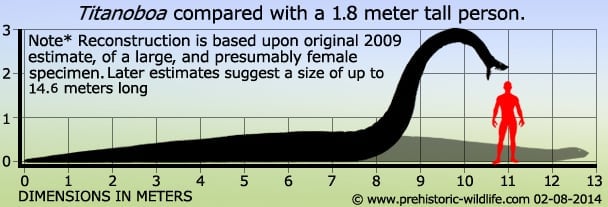 |
|
Tix Mascot
Tech guru
Italy is my second homeland
Posts: 11,093  Mini-Profile Background: {"image":"http://4.bp.blogspot.com/-X5mhw13BJ7Y/TwKeZ3uM7YI/AAAAAAAABPw/D82go4Ny_8E/s1600/italy-background-8-787281.jpg","color":""}
Mini-Profile Text Color: 0ef8f1
Mini-Profile Name Color: f40d39
Year of Birth: 1961
Nationality: Norwegian
Mini-Profile Background: {"image":"http://4.bp.blogspot.com/-X5mhw13BJ7Y/TwKeZ3uM7YI/AAAAAAAABPw/D82go4Ny_8E/s1600/italy-background-8-787281.jpg","color":""}
Mini-Profile Text Color: 0ef8f1
Mini-Profile Name Color: f40d39
Year of Birth: 1961
Nationality: Norwegian
|
Post by Tix Mascot on Jun 13, 2021 18:31:24 GMT
That thing looks ready to devour the poor human. LOL
|
|
|
|
Post by Joey12 on Jun 14, 2021 6:29:08 GMT
That's one big Nite crawler that we use to hunt. I would not want to run across one of these.
|
|
|
|
Post by Talira Greycrest on Jun 14, 2021 8:47:24 GMT
This animal is also known as the Giant Ground Sloth: Name: MegatheriumPronunciation: Meg-ah-fee-ree-umMeaning of name: "Great beast"Species: M. altiplanicum, M. urbinai, M. americanum, M. sundti, M. celendinense, M. medinae Size: Depending on species, measured up to 6 metres long, 4 metres tall when standing upright and weighing up to 4 metric tonnes.Family: Megatheriidae.Diet: Primarily herbivorous.First fossils found: Known from several specimens allowing for complete reconstruction. First discovered by Manuel Torres in Argentina in 1788. M. americanum named by French naturalist, Georges Cuvier, in 1796. M. sundti and M. medinae named in 1893. M. altiplanicum named in 2001. M. urbinai named in 2004. M. celendinense named in 2006.Lived: Depending on species, lived between 5.332 million years and 11,700 years ago from the Zanclean stage of the Early Pliocene through to the Tarantian stage of the Late Pleistocene in what is now Argentina, Peru, Bolivia and Ecuador.
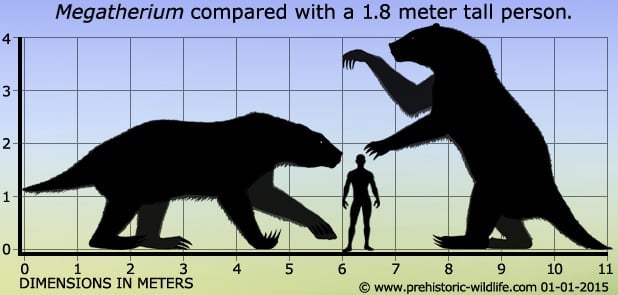 |
|
Tix Mascot
Tech guru
Italy is my second homeland
Posts: 11,093  Mini-Profile Background: {"image":"http://4.bp.blogspot.com/-X5mhw13BJ7Y/TwKeZ3uM7YI/AAAAAAAABPw/D82go4Ny_8E/s1600/italy-background-8-787281.jpg","color":""}
Mini-Profile Text Color: 0ef8f1
Mini-Profile Name Color: f40d39
Year of Birth: 1961
Nationality: Norwegian
Mini-Profile Background: {"image":"http://4.bp.blogspot.com/-X5mhw13BJ7Y/TwKeZ3uM7YI/AAAAAAAABPw/D82go4Ny_8E/s1600/italy-background-8-787281.jpg","color":""}
Mini-Profile Text Color: 0ef8f1
Mini-Profile Name Color: f40d39
Year of Birth: 1961
Nationality: Norwegian
|
Post by Tix Mascot on Jun 14, 2021 12:49:09 GMT
Wow, that was huge! Looks like a bear/beaver combo.
|
|
|
|
Post by Joey12 on Jun 15, 2021 5:45:46 GMT
I was thinking bear too.
|
|
|
|
Post by Talira Greycrest on Jun 15, 2021 6:01:01 GMT
A really big bird: Name: ArgentavisPronunciation: Ar-jen-tay-visMeaning of name: "Argentina bird". Species: A. magnificensWingspan: Estimated to have measured between 5.5 and 6.5 metres and weighing around 72kgs, making it one of the largest-known flying birds (twice the size of a Wandering Albatross).Family: TeratornithidaeDiet: CarnivoreFirst fossils found: Known from several partial skeletons discovered in the Epecuén and Andalhualá Formations of northwestern and central Argentina. Named by K. C. Campbell and E. C. Tonni in 1980.Lived: 9 to 6.8 million years ago during the Tortonian and Messinian stages of the Late Miocene in what is now northwestern and central Argentina.
 |
|
|
|
Post by Joey12 on Jun 15, 2021 7:26:28 GMT
Wow I'll bet that was something to see. That is Huge.
|
|
|
|
Post by Talira Greycrest on Jun 15, 2021 13:23:12 GMT
This mammal is named after a queen of ancient Egypt: Name: ArsinoitheriumPronunciation: Ar-si-noy-thee-ree-umMeaning of name: "Arsinoe's beast", after Queen Arsinoe 1st of Egypt.Species: A. zitteli, A. andrewsi, A. giganteusSize: 1.75 metres tall, 3 metres long and weighing around 1 metric tonne.Family: ArsinoitheriidaeDiet: Herbivore. Likely fed on low-growing vegetation.First fossils found: Known from several skeletons, some of which are almost complete, discovered in Oman, North Africa (Egypt, Libya, Tunisia), Saudi Arabia, southern Africa and eastern Africa. A. zitteli named by H. G. C. Beadnell in 1902. A. andrewsi named in 1903. A. giganteus named in 2004. This animal's most striking feature is the pair of massive horns on the head which were likely used for display. Males are thought to have had larger and more well-developed horns than females.Lived: Depending on species, lived between 36 and 27 million years ago from the Priabonian stage of the Late Eocene through to the Rupelian stage of the Early Oligocene in what is now Saudi Arabia, Oman, North Africa, eastern Africa and southern Africa.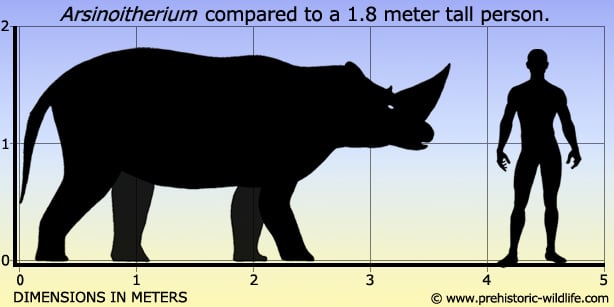 |
|
Tix Mascot
Tech guru
Italy is my second homeland
Posts: 11,093  Mini-Profile Background: {"image":"http://4.bp.blogspot.com/-X5mhw13BJ7Y/TwKeZ3uM7YI/AAAAAAAABPw/D82go4Ny_8E/s1600/italy-background-8-787281.jpg","color":""}
Mini-Profile Text Color: 0ef8f1
Mini-Profile Name Color: f40d39
Year of Birth: 1961
Nationality: Norwegian
Mini-Profile Background: {"image":"http://4.bp.blogspot.com/-X5mhw13BJ7Y/TwKeZ3uM7YI/AAAAAAAABPw/D82go4Ny_8E/s1600/italy-background-8-787281.jpg","color":""}
Mini-Profile Text Color: 0ef8f1
Mini-Profile Name Color: f40d39
Year of Birth: 1961
Nationality: Norwegian
|
Post by Tix Mascot on Jun 15, 2021 16:30:03 GMT
Wow I'll bet that was something to see. That is Huge. So was probably also its daily buffet! |
|
|
|
Post by Joey12 on Jun 16, 2021 2:44:47 GMT
Wow I'll bet that was something to see. That is Huge. So was probably also its daily buffet! Daily you could eat on that for a week. But once killed it probably got ate fast. |
|
|
|
Post by Talira Greycrest on Jun 16, 2021 5:42:21 GMT
Here's a giant wombat! Name: ZygomaturusPronunciation: Zy-go-mat-yur-usMeaning of name: "Large cheeks".Species: Z. diahotensis, Z. gilli, Z. keanei, Z. keani, Z. tasmanicus, Z. trilobusSize: Depending on species, measured up to 2.5 metres long, 1.5 metres tall and weighing between 500 and 700kgs.Family: DiprotodontidaeDiet: Herbivore. Fed on low-growing vegetation.First fossils found: Known from several specimens discovered in south-western and south-eastern Australia. Named by Australian explorer, Sir George Macleay, in 1857. Zygomaturus is a smaller relative of the more famous Diprotodon.Lived: Between 7.264 million years and 11,700 years ago from the Messinian stage of the Late Miocene to the Tarantian stage of the Late Pleistocene in what is now south-eastern and south-western Australia.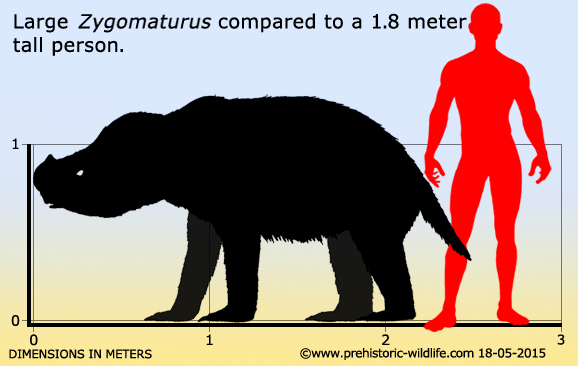 |
|
|
|
Post by Joey12 on Jun 17, 2021 2:59:56 GMT
Starting to look more bear like.
|
|
|
|
Post by Talira Greycrest on Jun 17, 2021 7:49:44 GMT
A relative of modern elephants: Name: DeinotheriumPronunciation: Dy-noe-thee-ree-umMeaning of name: "Terrible beast".Species: D. bozasi, D. giganteum, D. indicumSize: Depending on species, measured up to 6 metres long, 4 metres tall and weighing between 8 and 13.5 metric tonnes.Family: DeinotheriidaeDiet: Herbivore.First fossils found: Known from several specimens discovered in Romania, Pakistan, India and Kenya. D. giganteum named by German naturalist, Johann Jakob von Kaup, in 1829. D. indicum named by Scottish palaeontologist, Hugh Falconer, in 1845. D. bozasi named by French palaeontologist, Camille Arambourg, in 1934. Unlike modern elephants, whose tusks curve upwards and grow from the upper jaw, the tusks of Deinotherium curve downwards and grow from the lower jaw. It's possible they were used to uproot vegetation or strip bark from trees.Lived: Depending on species, lived from 15.97 to 1.806 million years ago from the Langhian stage of the Middle Miocene to the Gelasian stage of the Early Pleistocene in what is now Romania, India, Pakistan and Kenya.
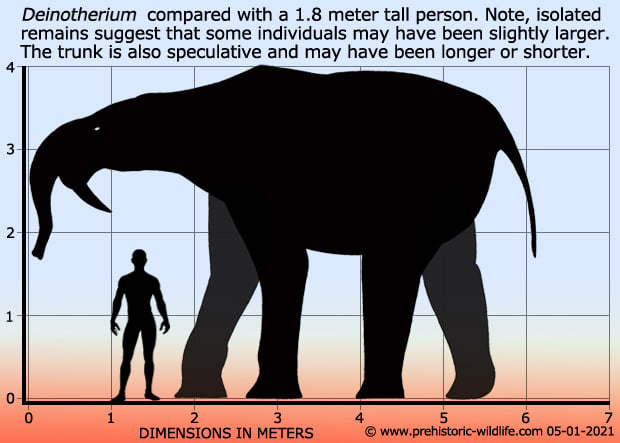 |
|
Tix Mascot
Tech guru
Italy is my second homeland
Posts: 11,093  Mini-Profile Background: {"image":"http://4.bp.blogspot.com/-X5mhw13BJ7Y/TwKeZ3uM7YI/AAAAAAAABPw/D82go4Ny_8E/s1600/italy-background-8-787281.jpg","color":""}
Mini-Profile Text Color: 0ef8f1
Mini-Profile Name Color: f40d39
Year of Birth: 1961
Nationality: Norwegian
Mini-Profile Background: {"image":"http://4.bp.blogspot.com/-X5mhw13BJ7Y/TwKeZ3uM7YI/AAAAAAAABPw/D82go4Ny_8E/s1600/italy-background-8-787281.jpg","color":""}
Mini-Profile Text Color: 0ef8f1
Mini-Profile Name Color: f40d39
Year of Birth: 1961
Nationality: Norwegian
|
Post by Tix Mascot on Jun 17, 2021 16:28:11 GMT
I guess there is much uncertainty and speculation going on, particularly where only few specimens sre found.
|
|